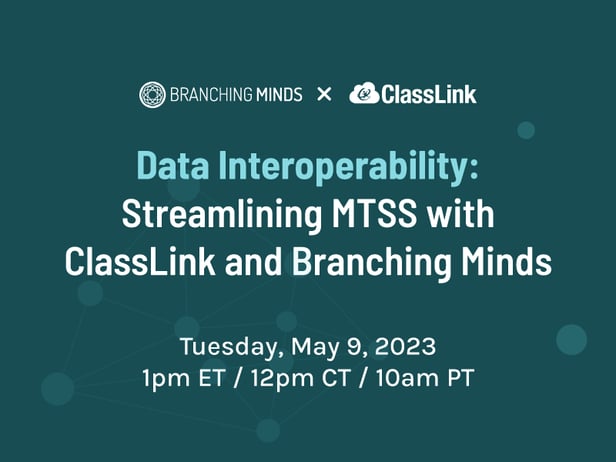I’m Sorry, Data What?
Educators are juggling an astonishing number of software platforms to help accomplish the goal of better instruction and student outcomes. When data cannot be easily shared between these platforms, teachers and administrators end up looking in multiple places for the data they need, or, even worse, duplicating their efforts as they try to support their students. Enter DATA INTEROPERABILITY.
Data interoperability refers to the ability of different computer systems to connect and exchange information with one another, in either implementation or accessibility, without restriction. (1)(5) Schools need to align their data practices and create standards that enable better connectivity around the suite of products and tools they use. The data interoperability framework provides the context for identifying and debating interoperability issues to make integration within this complex system easier. (2)
As it relates to a Multi-Tiered System of Supports (MTSS), the data interoperability framework allows districts to layer consistent data practices into a viable foundation for effective instruction and intervention work. It introduces a level of transparency at the district level, as now everyone involved in data work has access to the resources that the organization needs to produce consistent data products. When a school district’s software systems do a better job of communicating vital information internally, it makes implementing MTSS easier. In addition, open data standards that create an easier path to internal data connectivity are especially beneficial to smaller school districts that may not have had the opportunity or staffing to build out these frameworks internally.
For successful implementation of the data interoperability framework, please consider the following:
The Importance of Uniformity
Standardizing how data is organized seems simple enough at the outset, but taking special attention to how columns and rows are laid down throughout a dataset clarifies data management. Homogenizing how data is formatted by adhering to industry-leading data standards such as Ed-Fi, for example, enables greater cohesion between internal software platforms as these standards are a set of rules for the collection, management, and organization of educational data that allow multiple systems to share their information in a seamless, actionable way.(3) This helps the interoperability implementation by promoting a standard that lends itself to further portability.
Promoting Granularity Within Your Organization’s Data
Data granularity is a measure of the level of detail in a data structure. The level of granularity determines what data analysis can be performed and whether the results from that analysis lead to appropriate conclusions. (4) For example, take the name field in a dataset of student assessments—the name field could represent the full name or have separate entries for first name, middle name, and last name. Having separate entries can bring about a more complete abstraction of the dataset’s information which is important for internal and external stakeholders that want to glean insights from the organization’s proprietary data.
Establishing Best Practices for Data Workflows
Organizations often lack an agreed-upon standard for importing and exporting relevant data pieces. Many methods can exist in a school district to facilitate importing or exporting the data received from the multiple sources available to them, such as proprietary databases, assessment vendors, and rostering service providers. Those can range from importing/exporting a .csv (comma-separated values) file manually from a district resource, scheduling sFTP (Secure File Transfer Protocol) imports/exports to occur routinely from a given database, or facilitating data imports/exports through product integrations via an API (Application Programming Interface).
Having a standardized practice enables seamless transactions for the various data-centric products used within a school district. While that might imply that these processes are automatic in how they work, that may not be the case. It is important to be realistic in expectations for how well the services used within your organization “talk to each other” at the district and campus level. A flowchart or other guide can help district employees understand how the services they use interact with one another.
Additionally, establishing a regular cadence for imports/exports helps teachers coordinate their tiering efforts and can help visibility at the district level concerning the MTSS process, saving everyone time.
Outlining Data Security Protocols as Concisely as Possible
We all want ease of use regarding the data we share with our colleagues and stakeholders within an organization. However, it is not acceptable for educators and school administrators to send student data containing Personally Identifiable Information (PII) over email or other unsecured channels.
Having clear-cut data security procedures in an organization ensures everyone can access the data they need without compromising student privacy. Using services with end-to-end encryption should be the norm and not the exception when sharing student data with 3rd parties or anyone within the school district context. Account permissions, authentication protocols, VPN, and network safeguards such as firewalls and domain whitelisting should be used to give permanence to data security methodologies at the district level.
BRANCHING MINDS AND DATA INTEROPERABILITYAt Branching Minds, data interoperability is central to everything we do because an effective MTSS hinges on teachers’ ability to access the data they need: The Branching Minds platform is enabled for student information systems such as Clever, ClassLink, and RicOne, we support the Infinite Campus OneRoster API, and are compliant with One Roster CSV files, managed by school district exports. Districts can also send student demographic data, IEP/504 status, FRL status, attendance concerns, gifted/talented status, and English proficiency. Both student behavior incidents and testing accommodations can be imported into and exported out of Branching Minds.
|
Reigning in Gatekeeping
For data interoperability’s infrastructure to benefit the MTSS implementation process, it’s important to reign in gatekeepers. Unnecessary barriers can disable the sharing of actionable information, hampering educators in their ability to meet the needs of students. User permissions features are baked into most relational databases and data governance systems as a way to control who has write access to said databases, deterring possible bad actors in the process.
Upkeep of Documentation
The data interoperability framework’s success hinges on the creation and upkeep of documentation that details everything relevant to the implementation of your organization’s data practices. Documentation needs to be as clear and concise as possible for appropriate stakeholders. Data may not always be the most engaging topic, but success depends on regular training for participants. Learning Management Systems can provide this content in a digestible format.
Conclusion
The data interoperability framework plays a critical role in futureproofing our educational data practices—especially as it relates to MTSS . Open, transparent, yet fundamentally secure standards concerning data are key to success in effectively supporting the educational journey of every student.
Take-Aways
➡️ Data interoperability is the ability of different computer systems to connect and exchange information with one another without restriction.➡️ The data interoperability framework enables school districts to layer consistent data practices into a viable foundation for effective instruction and intervention work, making MTSS implementation easier.
➡️ For successful implementation of the data interoperability framework, it is important to focus on:
-
- Standardization
- Granularity
- Best practices for data workflows
- Data security protocols
- Documentation upkeep
💡 Related Resources:
How to Promote MTSS Data Literacy in Your District
|
|
Join the webinar:Learn more about how Branching Minds connects data, systems, interventions, and stakeholders to streamline the work of MTSS! Register today for this live webinar on Data Interoperability with Branching Minds and ClassLink.
|
|
Citations:
https://www.heavy.ai/technical-glossary/interoperability (1)
https://gridwiseac.org/pdfs/interopframework_v1_1.pdf (page. 4) (2)
https://www.ed-fi.org/what-is-ed-fi/ed-fi-data-standard/(3)
About the author
Branching Minds
Branching Minds is a highly respected K-12 services and technology company that leverages the learning sciences and technology to help districts effectively personalize learning through enhancements to their MTSS/RTI practice. Having worked with hundreds of districts across the country, we bring deep expertise in learning sciences, data management and analysis, software design, coaching, and collaboration. Combined with our extensive toolkit of resources, PD, and technology, we provide a system-level solution. We are more than a service or a software provider, we are partners who will deliver sustainable results for educators, and a path to success for every learner.

Your MTSS Transformation Starts Here
Enhance your MTSS process. Book a Branching Minds demo today.




















.png?width=716&height=522&name=MTSS-interventions-secondary-school(preview).png)